Cultural Heritage in Times of Crisis: Damage Assessment in Urban Areas of Ukraine Using Sentinel-1 SAR Data
Abstract
:1. Introduction
2. Materials and Methods
2.1. Study Sites
2.2. Sentinel-1 SAR Data
2.3. Open GIS Data
3. Damage Detection Methodology
3.1. SAR Coherence Estimation
3.2. Coherence Difference Calculation
4. Logistic Regression Analysis
4.1. Sample Data
4.2. Model Calibration
4.3. Model Performance Evaluation
4.4. Evaluation Based on UNOSAT Data
5. Damage Mapping Results
5.1. Overall Building Damage and Impact on Cultural Property
5.2. Changes along Time Series and Selected Heritage Sites
6. Discussion
7. Conclusions
Author Contributions
Funding
Data Availability Statement
Acknowledgments
Conflicts of Interest
References
- UNESCO. Convention for the Protection of Cultural Property in the Event of Armed Conflict with Regulations for the Execution of the Convention: Adopted 14 May 1954, The Hague, Netherlands. Available online: https://www.unesco.org/en/legal-affairs/convention-protection-cultural-property-event-armed-conflict-regulations-execution-convention (accessed on 1 June 2024).
- Psikowska-Schnass, M. Russia’s War on Ukraine’s Cultural Heritage. Available online: https://epthinktank.eu/2022/04/22/russias-war-on-ukraines-cultural-heritage/ (accessed on 1 June 2024).
- Casana, J.; Laugier, E.J. Satellite imagery-based monitoring of archaeological site damage in the Syrian civil war. PLoS ONE 2017, 12, e0188589. [Google Scholar] [CrossRef] [PubMed]
- UNESCO. Damaged Cultural Sites in Ukraine Verified by UNESCO. Available online: https://www.unesco.org/en/articles/damaged-cultural-sites-ukraine-verified-unesco (accessed on 1 June 2024).
- UNITAR. United Nations Satellite Centre UNOSAT. Available online: https://www.unitar.org/sustainable-development-goals/united-nations-satellite-centre-UNOSAT (accessed on 1 June 2024).
- Huang, Q.; Jin, G.; Xiong, X.; Ye, H.; Xie, Y. Monitoring Urban Change in Conflict from the Perspective of Optical and SAR Satellites: The Case of Mariupol, a City in the Conflict between RUS and UKR. Remote Sens. 2023, 15, 3096. [Google Scholar] [CrossRef]
- Malmgren-Hansen, D.; Sohnesen, T.; Fisker, P.; Baez, J. Sentinel-1 Change Detection Analysis for Cyclone Damage Assessment in Urban Environments. Remote Sens. 2020, 12, 2409. [Google Scholar] [CrossRef]
- Mastro, P.; Masiello, G.; Serio, C.; Pepe, A. Change Detection Techniques with Synthetic Aperture Radar Images: Experiments with Random Forests and Sentinel-1 Observations. Remote Sens. 2022, 14, 3323. [Google Scholar] [CrossRef]
- Olen, S.; Bookhagen, B. Mapping Damage-Affected Areas after Natural Hazard Events Using Sentinel-1 Coherence Time Series. Remote Sens. 2018, 10, 1272. [Google Scholar] [CrossRef]
- Tapete, D.; Cigna, F. Trends and perspectives of space-borne SAR remote sensing for archaeological landscape and cultural heritage applications. J. Archaeol. Sci. Rep. 2017, 14, 716. [Google Scholar] [CrossRef]
- Preiss, M.; Stacy, N.J.S. Coherent Change Detection: Theoretical Description and Experimental Results; DSTO-TR-1851; Defense Technical Information Center: Fort Belvoir, VA, USA, 2006. [Google Scholar]
- Closson, D.; Milisavljevic, N. InSAR Coherence and Intensity Changes Detection. In Mine Action—The Research Experience of the Royal Military Academy of Belgium; Beumier, C., Closson, D., Lacroix, V., Milisavljevic, N., Yvinec, Y., Eds.; InTech: London, UK, 2017. [Google Scholar] [CrossRef]
- Plank, S. Rapid Damage Assessment by Means of Multi-Temporal SAR—A Comprehensive Review and Outlook to Sentinel-1. Remote Sens. 2014, 6, 4870–4906. [Google Scholar] [CrossRef]
- Lu, C.-H.; Ni, C.-F.; Chang, C.-P.; Yen, J.-Y.; Chuang, R. Coherence Difference Analysis of Sentinel-1 SAR Interferogram to Identify Earthquake-Induced Disasters in Urban Areas. Remote Sens. 2018, 10, 1318. [Google Scholar] [CrossRef]
- Tzouvaras, M.; Danezis, C.; Hadjimitsis, D.G. Small Scale Landslide Detection Using Sentinel-1 Interferometric SAR Coherence. Remote Sens. 2020, 12, 1560. [Google Scholar] [CrossRef]
- FAO. Impact of the May Conflict Escalation on the Agricultural Area in the Gaza Strip; Food and Agriculture Organization of the United Nations (FAO): Rome, Italy, 2021. [Google Scholar] [CrossRef]
- Tapete, D.; Cigna, F.; Donoghue, D.N.; Philip, G. Mapping Changes and Damages in Areas of Conflict: From Archive C-band SAR Data to New HR X-band Imagery, towards the Sentinels. In Proceedings of the Fringe 2015: Advances in the Science and Applications of SAR Interferometry and Sentinel-1 InSAR Workshop, Frascati, Italy, 23–27 March 2015; Ouwehand, L., Ed.; ESA Publication SP-731: Noordwijk, The Netherlands, 2015. [Google Scholar] [CrossRef]
- An, L.; Zhang, J.; Gong, L. Earthquake Building Damage Mapping Based on Feature Analyzing Method from Synthetic Aperture Radar Data. Int. Arch. Photogramm. Remote Sens. Spat. Inf. Sci. 2018, XLII-3, 39–43. [Google Scholar] [CrossRef]
- Ge, P.; Gokon, H.; Meguro, K. Building Damage Assessment Using Intensity SAR Data with Different Incidence Angles and Longtime Interval. J. Disaster Res. 2019, 14, 456–465. [Google Scholar] [CrossRef]
- Tapete, D.; Cigna, F. COSMO-SkyMed SAR for Detection and Monitoring of Archaeological and Cultural Heritage Sites. Remote Sens. 2019, 11, 1326. [Google Scholar] [CrossRef]
- Braun, A. Assessment of Building Damage in Raqqa during the Syrian Civil War Using Time-Series of Radar Satellite Imagery. GI_Forum 2018, 1, 228. [Google Scholar] [CrossRef]
- Boloorani, A.D.; Darvishi, M.; Weng, Q.; Liu, X. Post-War Urban Damage Mapping Using InSAR: The Case of Mosul City in Iraq. ISPRS Int. J. Geo-Inf. 2021, 10, 140. [Google Scholar] [CrossRef]
- ElGharbawi, T.; Zarzoura, F. Damage detection using SAR coherence statistical analysis, application to Beirut, Lebanon. ISPRS J. Photogramm. Remote Sens. 2021, 173, 1–9. [Google Scholar] [CrossRef]
- Aimaiti, Y.; Sanon, C.; Koch, M.; Baise, L.G.; Moaveni, B. War Related Building Damage Assessment in Kyiv, Ukraine, Using Sentinel-1 Radar and Sentinel-2 Optical Images. Remote Sens. 2022, 14, 6239. [Google Scholar] [CrossRef]
- Fakhri, F.; Gkanatsios, I. Integration of Sentinel-1 and Sentinel-2 data for change detection: A case study in a war conflict area of Mosul city. Remote Sens. Appl. Soc. Environ. 2021, 22, 100505. [Google Scholar] [CrossRef]
- Hasanlou, M.; Shah-Hosseini, R.; Seydi, S.T.; Karimzadeh, S.; Matsuoka, M. Earthquake Damage Region Detection by Multitemporal Coherence Map Analysis of Radar and Multispectral Imagery. Remote Sens. 2021, 13, 1195. [Google Scholar] [CrossRef]
- Sharma, A. Gaza Damage Assessment using Earth Observation Data: Monitoring Structural Damage to Buildings in North Gaza Using Sentinel 2 Satellite Imagery during the Recent Israeli-Palestinian Conflict. Available online: https://medium.com/geekculture/2021-gaza-damage-assessment-using-earth-observation-data-8e6c9c66b808 (accessed on 24 September 2022).
- Mihi, A.; Ghazela, R.; Wissal, D. Mapping potential desertification-prone areas in North-Eastern Algeria using logistic regression model, GIS, and remote sensing techniques. Environ. Earth Sci. 2022, 81, 385. [Google Scholar] [CrossRef]
- Nick, T.G.; Campbell, K.M. Logistic Regression. Methods Mol. Biol. 2007, 404, 273–301. [Google Scholar] [CrossRef]
- Washaya, P.; Balz, T.; Mohamadi, B. Coherence Change-Detection with Sentinel-1 for Natural and Anthropogenic Disaster Monitoring in Urban Areas. Remote Sens. 2018, 10, 1026. [Google Scholar] [CrossRef]
- Yerushalmy, J. Mariupol before and after: Updated Google Maps Reveal Destruction in Ukraine City. The Guardian, 28 April 2023. Available online: https://www.theguardian.com/world/2023/apr/28/mariupol-before-and-after-updated-google-maps-reveal-destruction-in-ukraine-city (accessed on 6 June 2024).
- BBC News. Ukraine Conflict: Russia Bombs Kharkiv’s Freedom Square and Opera House. BBC. 1 March 2022. Available online: https://bbc.com/news/world-europe-60567162 (accessed on 25 February 2024).
- Bachelet, M. High Commissioner Updates Human Rights Council on Mariupol, Ukraine. Available online: https://www.ohchr.org/en/statements/2022/06/high-commissioner-updates-human-rights-council-mariupol-ukraine (accessed on 28 December 2023).
- Henley, J. Moscow Confirms Attack on Kyiv during UN Chief’s Visit: Kremlin Admits Airstrike as Ukraine Acknowledges Heavy Losses from Russian Attack in East. The Guardian. 29 April 2022. Available online: https://www.theguardian.com/world/2022/apr/29/russia-carries-out-airstrike-on-kyiv-during-un-chief-visit-ukraine-antonio-guterres (accessed on 2 June 2024).
- UNOSAT. Damage Assessment Overview Map. Ukraine. Livoberezhnyi and Zhovtnevyi Districts, Mariupol City: Imagery Analysis 7, 8, 12 May 2022 and 14 March 2022. Product ID: 3300. Published 15 June 2022. Available online: https://unosat.org/products/3300 (accessed on 21 February 2023).
- UNOSAT. Damage Assessment Overview Map. Ukraine. Kharkiv, Kharkiv Oblast: Imagery Analysis 15 June 2022. Product ID: 3455. Published 25 November 2022. Available online: https://unosat.org/products/3455 (accessed on 21 February 2023).
- Alaska Satellite Facility. Distributed Active Archive Center. Available online: https://search.asf.alaska.edu/ (accessed on 2 June 2024).
- Yague-Martinez, N.; Prats-Iraola, P.; Rodriguez Gonzalez, F.; Brcic, R.; Shau, R.; Geudtner, D.; Eineder, M.; Bamler, R. Interferometric Processing of Sentinel-1 TOPS Data. IEEE Trans. Geosci. Remote Sens. 2016, 54, 2220–2234. [Google Scholar] [CrossRef]
- Serco Italia SPA. Lebanon Damage Assessment with Sentinel-1 & Sentinel-2. Version 1.1. 2020. Available online: https://eo4society.esa.int/wp-content/uploads/2022/01/HAZA08_Lebanon-Damage-Assessment.pdf (accessed on 24 November 2023).
- Deepthi, R.; Ravindranath, S.; Raj, K.G. Extraction of Urban Footprint of Bengaluru City Using Microwave Remote Sensing. Int. Arch. Photogramm. Remote Sens. Spat. Inf. Sci. 2018, XLII-5, 735–740. [Google Scholar] [CrossRef]
- Seymour, M.S.; Cumming, I.G. Maximum likelihood estimation for SAR interferometry. In Proceedings of the IGARSS’94—1994 IEEE International Geoscience and Remote Sensing Symposium, Pasadena, CA, USA, 8–12 August 1994; IEEE: Piscataway, NJ, USA, 1994; pp. 2272–2275. [Google Scholar]
- Braun, A.; Veci, L. Sentinel-1 Toolbox: TOPS Interferometry Tutorial. 2021. Available online: https://step.esa.int/docs/tutorials/S1TBX%20TOPSAR%20Interferometry%20with%20Sentinel-1%20Tutorial_v2.pdf (accessed on 7 May 2023).
- Lazecký, M.; Hlaváčová, I.; Martinovič, J.; Ruiz-Armenteros, A.M. Accuracy of Sentinel-1 Interferometry Monitoring System based on Topography-free Phase Images. Procedia Comput. Sci. 2018, 138, 310–317. [Google Scholar] [CrossRef]
- ESA. Scientific Toolbox Exploitation Platform. Available online: http://step.esa.int/ (accessed on 2 June 2024).
- Geofabrik GmbH. Ukraine (with Crimea). Available online: https://download.geofabrik.de/europe/ukraine.html (accessed on 2 June 2024).
- OCHA. Humanitarian Data Exchange: Ukraine—Subnational Administrative Boundaries. Available online: https://data.humdata.org/dataset/cod-ab-ukr? (accessed on 2 June 2024).
- Scheuchl, B.; Ullmann, T.; Koudogbo, F. Change Detection Using High Resolution Terrasar-X Data: Preliminary Results. Int. Arch. Photogramm. Remote Sens. Spat. Inf. Sci. 2009, 38, 1–47. [Google Scholar]
- Stephenson, O.L.; Kohne, T.; Zhan, E.; Cahill, B.E.; Yun, S.-H.; Ross, Z.E.; Simons, M. Deep Learning-Based Damage Mapping With InSAR Coherence Time Series. IEEE Trans. Geosci. Remote Sens. 2022, 60, 5207917. [Google Scholar] [CrossRef]
- ESA. Copernicus Open Access Hub. Available online: https://scihub.copernicus.eu/ (accessed on 8 January 2024).
- Saputra, A.; Rahardianto, T.; Revindo, M.D.; Delikostidis, I.; Hadmoko, D.S.; Sartohadi, J.; Gomez, C. Seismic vulnerability assessment of residential buildings using logistic regression and geographic information system (GIS) in Pleret Sub District (Yogyakarta, Indonesia). Geoenviron. Disasters 2017, 4, 11. [Google Scholar] [CrossRef]
- Han, J.; Park, S.; Kim, S.; Son, S.; Lee, S.; Kim, J. Performance of Logistic Regression and Support Vector Machines for Seismic Vulnerability Assessment and Mapping: A Case Study of the 12 September 2016 ML5.8 Gyeongju Earthquake, South Korea. Sustainability 2019, 11, 7038. [Google Scholar] [CrossRef]
- Chen, S.; Chen, J.; Yu, J.; Wang, T.; Xu, J. Prediction of Deterioration Level of Heritage Buildings Using a Logistic Regression Model. Buildings 2023, 13, 1006. [Google Scholar] [CrossRef]
- Dobson, A.; Barnett, A. An Introduction to Generalized Linear Models; Chapman and Hall/CRC: New York, NY, USA, 2008. [Google Scholar] [CrossRef]
- McCullagh, P.; Nelder, J.A. Generalized Linear Models; Monographs on Statistics and Applied Probability; Champman and Hall/CRC: New York, NY, USA, 2001. [Google Scholar]
- Hastie, T.J.; Pregibon, D. Generalized linear models. In Statistical Models in S; Routledge: London, UK, 2017; pp. 195–247. [Google Scholar]
- Robin, X.; Turck, N.; Hainard, A.; Tiberti, N.; Lisacek, F.; Sanchez, J.-C.; Müller, M. pROC: An open-source package for R and S+ to analyze and compare ROC curves. BMC Bioinform. 2011, 12, 77. [Google Scholar] [CrossRef]
- Melo, F. Area under the ROC Curve. In Encyclopedia of Systems Biology; Dubitzky, W., Wolkenhauer, O., Cho, K.-H., Yokota, H., Eds.; Springer: New York, NY, USA, 2013; pp. 38–39. [Google Scholar] [CrossRef]
- Kuhn, M. Building Predictive Models in R Using the caret Package. J. Stat. Softw. 2008, 28, 1–26. [Google Scholar] [CrossRef]
- Putri, A.F.S.; Wirastuti, W.; Umarhadi, D.A. Sentinel-1 and Sentinel-2 data fusion to distinguish building damage level of the 2018 Lombok Earthquake. Remote Sens. Appl. Soc. Environ. 2022, 26, 100724. [Google Scholar] [CrossRef]
- Liveuamap. Photos of Damage Nikolsky Mall in Kharkiv after Russian Army Shelling. Available online: https://liveuamap.com/en/2022/10-march-photos-of-damage-nikolsky-mall-in-kharkiv-after (accessed on 9 March 2024).
- Watanabe, M.; Thapa, R.B.; Ohsumi, T.; Fujiwara, H.; Yonezawa, C.; Tomii, N.; Suzuki, S. Detection of damaged urban areas using interferometric SAR coherence change with PALSAR-2. Earth Planets Space 2016, 68, 131. [Google Scholar] [CrossRef]
- Ge, P.; Gokon, H.; Meguro, K. A review on synthetic aperture radar-based building damage assessment in disasters. Remote Sens. Environ. 2020, 240, 111693. [Google Scholar] [CrossRef]
- Lee, S. Application of logistic regression model and its validation for landslide susceptibility mapping using GIS and remote sensing data. Int. J. Remote Sens. 2005, 26, 1477–1491. [Google Scholar] [CrossRef]
- Zebker, H.A.; Villasenor, J. Decorrelation in interferometric radar echoes. IEEE Trans. Geosci. Remote Sens. 1992, 30, 950–959. [Google Scholar] [CrossRef]
- Garzo, P.A.; Fernández-Montblanc, T. Land Use/Land Cover Optimized SAR Coherence Analysis for Rapid Coastal Disaster Monitoring: The Impact of the Emma Storm in Southern Spain. Remote Sens. 2023, 15, 3233. [Google Scholar] [CrossRef]

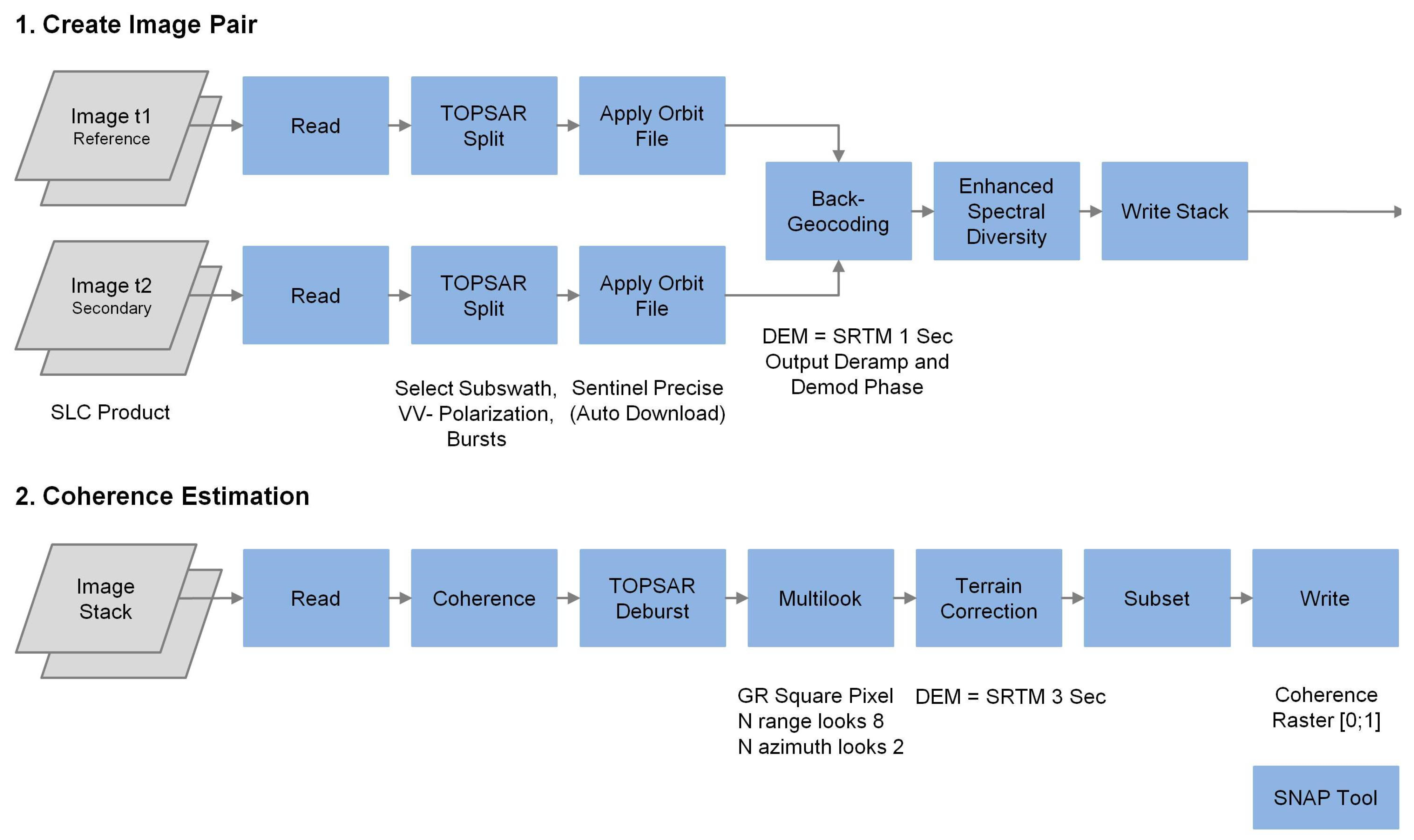



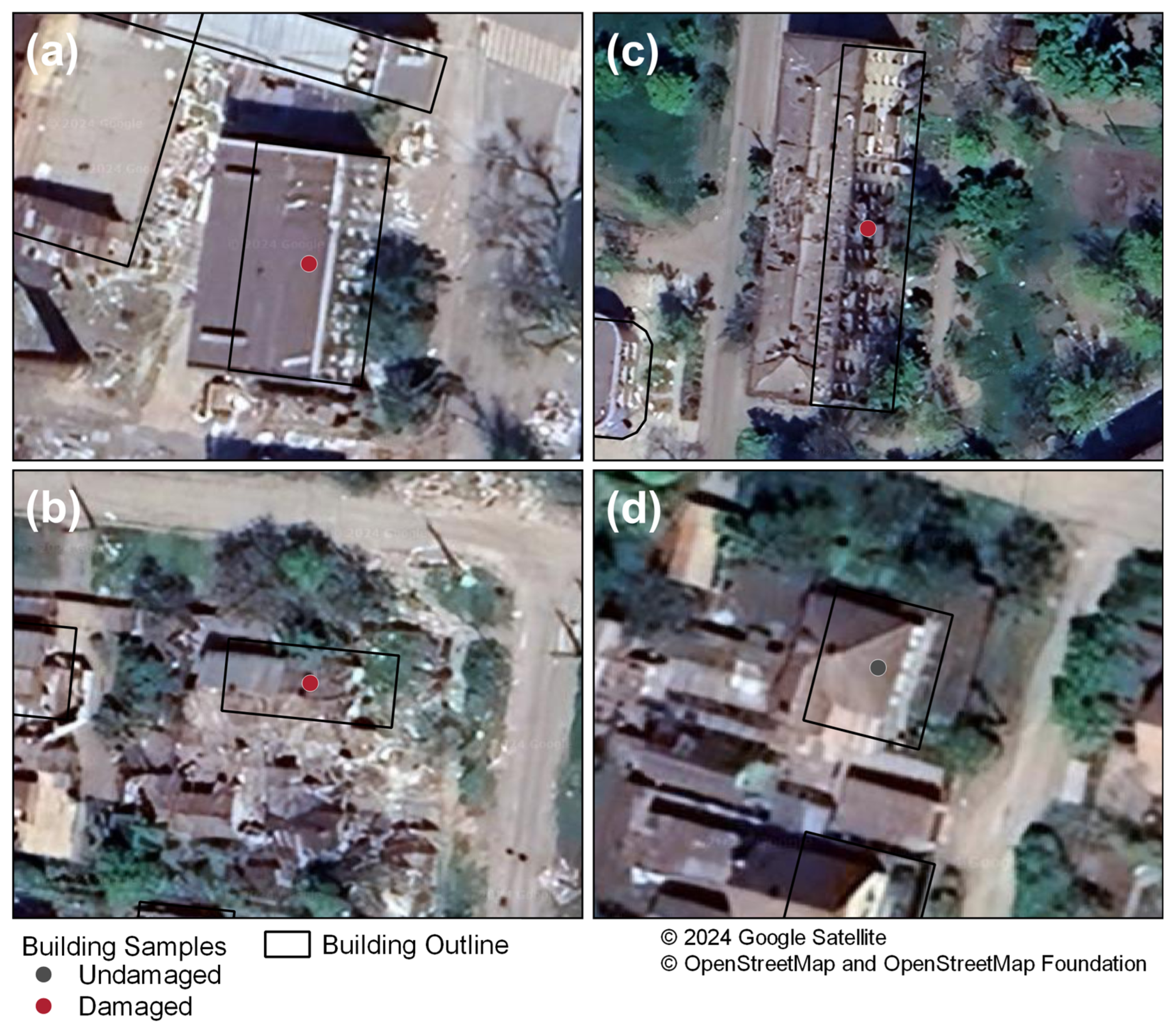
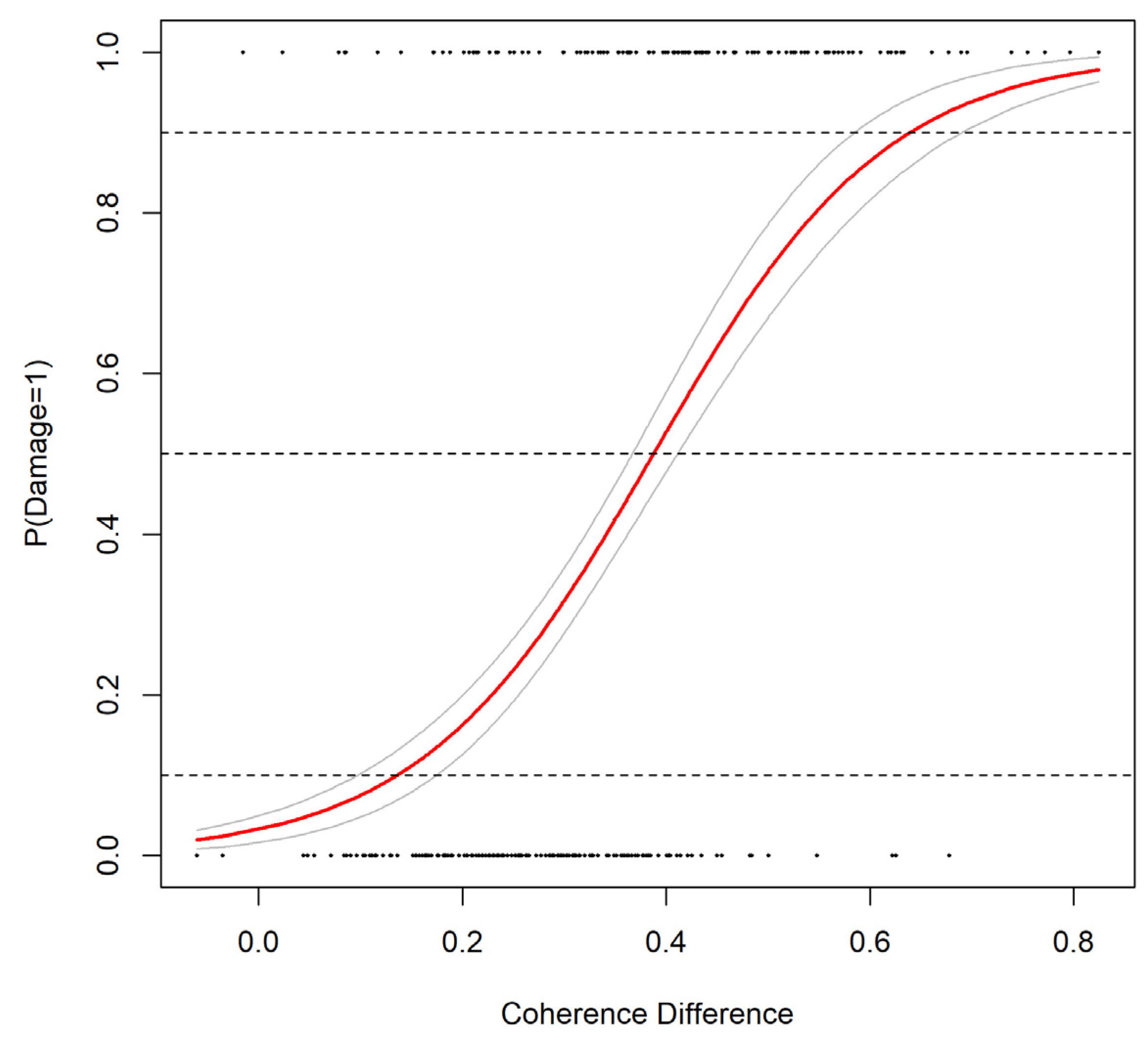


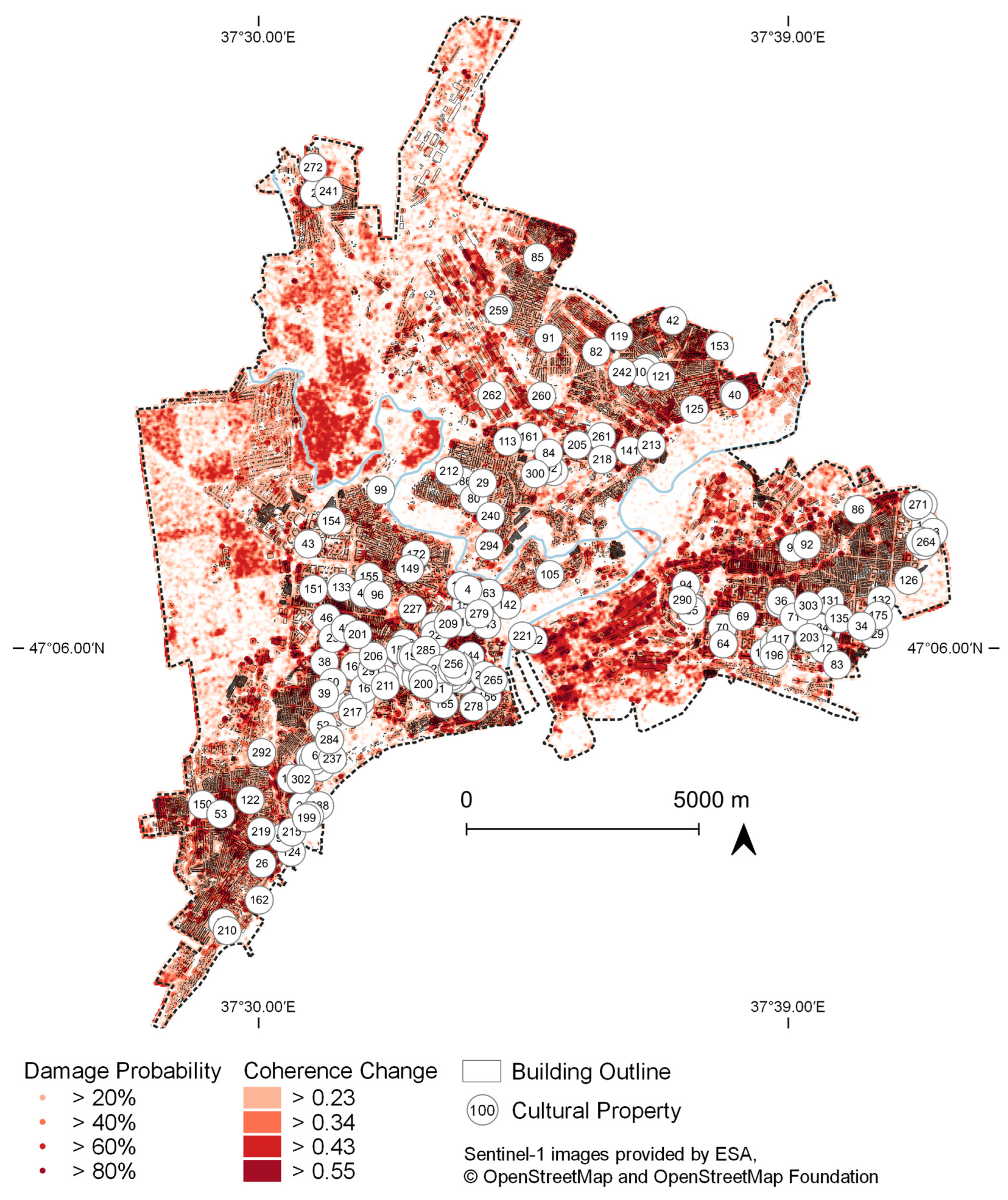


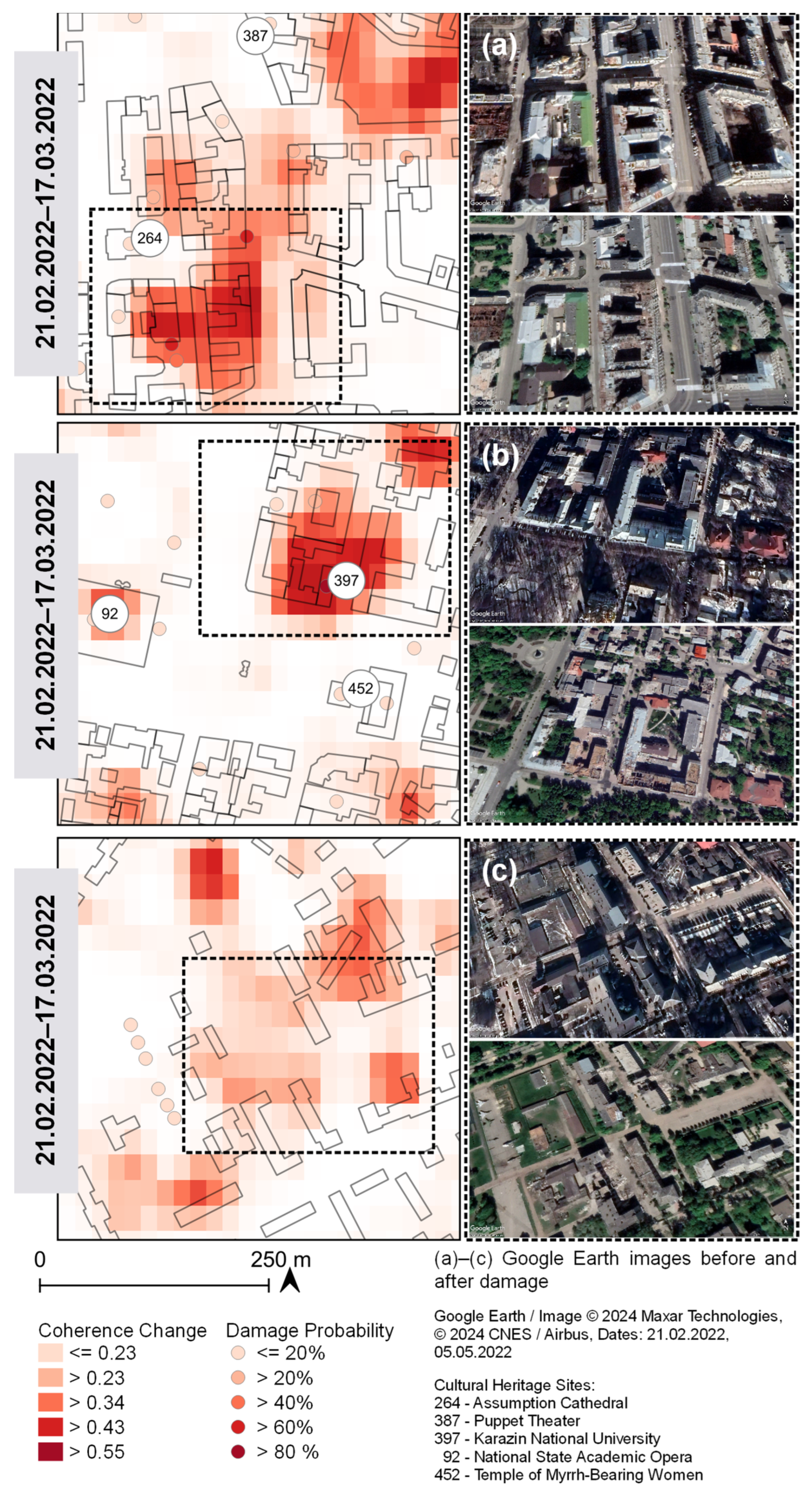
| Acquisition | Platform | Sensor | Mode | Polarization | Path | Product | Direction |
|---|---|---|---|---|---|---|---|
| Mariupol | |||||||
| 4 February 2022 (t1) | Sentinel-1A | C-SAR | IW | VV + VH | 43 | SLC | Ascending |
| 16 February 2022 (t2) | Sentinel-1A | C-SAR | IW | VV + VH | 43 | SLC | Ascending |
| 12 March 2022 (t3) | Sentinel-1A | C-SAR | IW | VV + VH | 43 | SLC | Ascending |
| 5 April 2022 (t4) | Sentinel-1A | C-SAR | IW | VV + VH | 43 | SLC | Ascending |
| 23 May 2022 (t5) | Sentinel-1A | C-SAR | IW | VV + VH | 43 | SLC | Ascending |
| Kharkiv | |||||||
| 9 February 2022 (t1) | Sentinel-1A | C-SAR | IW | VV + VH | 116 | SLC | Ascending |
| 21 February 2022 (t2) | Sentinel-1A | C-SAR | IW | VV + VH | 116 | SLC | Ascending |
| 17 March 2022 (t3) | Sentinel-1A | C-SAR | IW | VV + VH | 116 | SLC | Ascending |
| 10 April 2022 (t4) | Sentinel-1A | C-SAR | IW | VV + VH | 116 | SLC | Ascending |
| 28 May 2022 (t5) | Sentinel-1A | C-SAR | IW | VV + VH | 116 | SLC | Ascending |
| Coherence | Reference | Secondary | Time-Lag [d] | Mean | Std | 1st Qu | 3rd Qu |
|---|---|---|---|---|---|---|---|
| Mariupol | |||||||
| Coh1 | 4 February 2022 | 16 February 2022 | 12 | 0.700 | 0.144 | 0.622 | 0.806 |
| Coh2 | 16 February 2022 | 12 March 2022 | 24 | 0.612 | 0.152 | 0.518 | 0.721 |
| Coh3 | 12 March 2022 | 5 April 2022 | 24 | 0.499 | 0.190 | 0.352 | 0.647 |
| Coh4 | 5 April 2022 | 23 May 2022 | 48 | 0.505 | 0.189 | 0.365 | 0.650 |
| Cohtot | 16 February 2022 | 23 May 2022 | 96 | 0.387 | 0.175 | 0.244 | 0.513 |
| Kharkiv | |||||||
| Coh1 | 9 February 2022 | 21 February 2022 | 12 | 0.514 | 0.171 | 0.391 | 0.633 |
| Coh2 | 21 February 2022 | 17 March 2022 | 24 | 0.466 | 0.164 | 0.345 | 0.578 |
| Coh3 | 17 March 2022 | 10 April 2022 | 24 | 0.461 | 0.166 | 0.338 | 0.576 |
| Coh4 | 10 April 2022 | 28 May 2022 | 48 | 0.575 | 0.181 | 0.450 | 0.708 |
| Cohtot | 21 February 2022 | 28 May 2022 | 96 | 0.473 | 0.180 | 0.337 | 0.600 |
| Group | Nr. Mariupol | Nr. Kharkiv |
|---|---|---|
| Religious Sites | 47 | 103 |
| (Type: Cathedral, Church, Temple) | ||
| Cultural Sites | 135 | 392 |
| (Type: Archaeological, Arts Center, Library, Museum, Theatre, Memorial, Monument, Artwork) | ||
| Educational Sites | 124 | 336 |
| (Type: College, School, University) | ||
| Total | 306 | 831 |
| Confidence Interval | ||||||
|---|---|---|---|---|---|---|
| Estimate | SE | z | p | 2.5% | 97.5% | |
| Intercept | −3.389 | 0.267 | −12.69 | <2 × 10−16 | −3.913 | −2.866 |
| ΔCohtot | 8.747 | 0.741 | 11.80 | <2 × 10−16 | 7.295 | 10.199 |
| Estimated Damage Probability | ||||||
|---|---|---|---|---|---|---|
| N per Group | <20% | 20–40% | 40–60% | 60–80% | >80% | |
| Buildings | 18,110 | 16,008 | 10,116 | 7651 | 4900 | N = 56,785 |
| 39.9% of total buildings | ||||||
| Heritage Sites 1 | 102 | 79 | 48 | 45 | 32 | N = 306 |
| 40.8% of total heritage sites | ||||||
| Estimated Damage Probability | ||||||
|---|---|---|---|---|---|---|
| N per Group | <20% | 20–40% | 40–60% | 60–80% | >80% | |
| Buildings | 79,949 | 5679 | 973 | 217 | 53 | N = 86,871 |
| 1.4% of total buildings | ||||||
| Heritage Sites 1 | 795 | 28 | 6 | - | 2 | N = 831 |
| 0.7% of total heritage sites | ||||||
Disclaimer/Publisher’s Note: The statements, opinions and data contained in all publications are solely those of the individual author(s) and contributor(s) and not of MDPI and/or the editor(s). MDPI and/or the editor(s) disclaim responsibility for any injury to people or property resulting from any ideas, methods, instructions or products referred to in the content. |
© 2024 by the authors. Published by MDPI on behalf of the International Society for Photogrammetry and Remote Sensing. Licensee MDPI, Basel, Switzerland. This article is an open access article distributed under the terms and conditions of the Creative Commons Attribution (CC BY) license (https://creativecommons.org/licenses/by/4.0/).
Share and Cite
Bachmann-Gigl, U.; Dabiri, Z. Cultural Heritage in Times of Crisis: Damage Assessment in Urban Areas of Ukraine Using Sentinel-1 SAR Data. ISPRS Int. J. Geo-Inf. 2024, 13, 319. https://doi.org/10.3390/ijgi13090319
Bachmann-Gigl U, Dabiri Z. Cultural Heritage in Times of Crisis: Damage Assessment in Urban Areas of Ukraine Using Sentinel-1 SAR Data. ISPRS International Journal of Geo-Information. 2024; 13(9):319. https://doi.org/10.3390/ijgi13090319
Chicago/Turabian StyleBachmann-Gigl, Ute, and Zahra Dabiri. 2024. "Cultural Heritage in Times of Crisis: Damage Assessment in Urban Areas of Ukraine Using Sentinel-1 SAR Data" ISPRS International Journal of Geo-Information 13, no. 9: 319. https://doi.org/10.3390/ijgi13090319
APA StyleBachmann-Gigl, U., & Dabiri, Z. (2024). Cultural Heritage in Times of Crisis: Damage Assessment in Urban Areas of Ukraine Using Sentinel-1 SAR Data. ISPRS International Journal of Geo-Information, 13(9), 319. https://doi.org/10.3390/ijgi13090319







